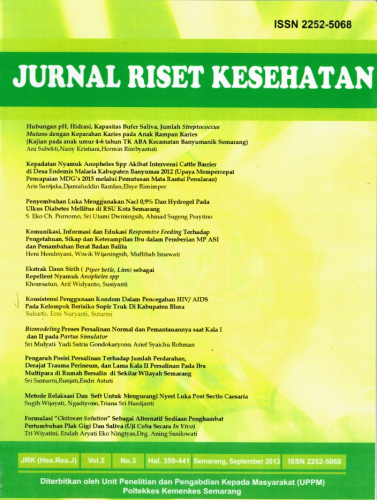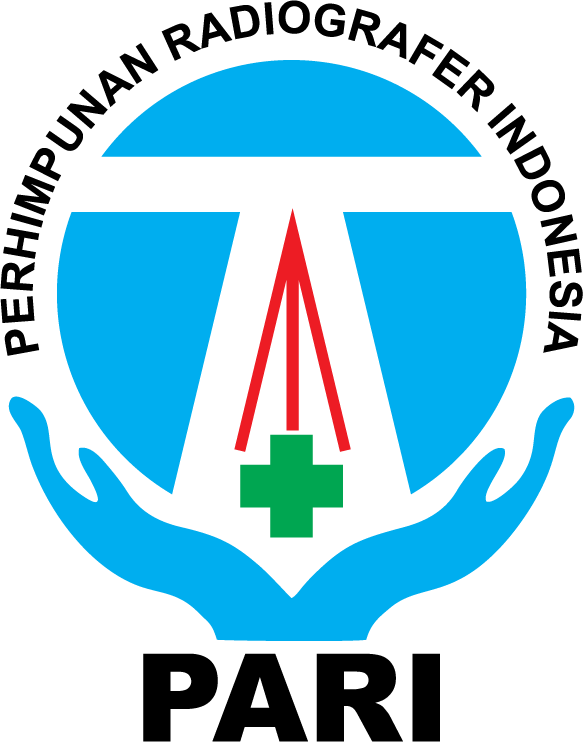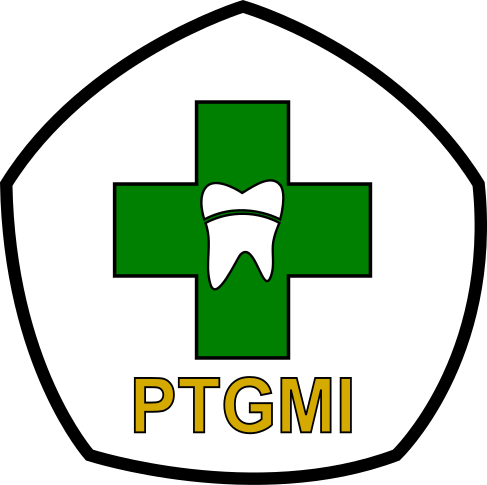THE EFFECTIVENESS OF ETHANOL EXTRACT OF JAMBLANG LEAVES (Syzygium cumini L.) IN INCREASING HDL LEVELS IN WISTAR RATS MODELS OF METABOLIC SYNDROME
Abstract
One of the characteristics of metabolic syndrome (MetS) is the low high-density lipoprotein (HDL) levels. Jamblang leaves (Syzygium cumini L.) contain various phytochemicals, which have antihyperglycemic, antihyperlipidemic, and antioxidant properties. This study aims to demonstrate the effectiveness of ethanol extract of jamblang leaves in increasing HDL levels in the Wistar rats model of MetS. A pretest-posttest with a control group design was conducted using 30 male Wistar rats, divided into five groups randomly, with six rats for each group. Here, KN means normal control group, K- negative control group, and P1, P2, and P3: treatment groups that were administered the 100 mg/kg/day, 150 mg/kg/day, and 200 mg/kg/day of ethanol extract of jamblang leaves for 28 days, respectively. The rat MetS model was developed by administering the high-fat fructose diet and streptozotocin-nicotinamide. The data were analyzed using paired t-test and one-way ANOVA (α=0.05). This study found that extract administration in P2 and P3 increased HDL levels significantly, but not with the P1 group. However, HDL levels in P1 were significantly higher compared to the K- group. Moreover, increasing the dose was significantly followed by higher HDL levels, although the highest dose did not reach the HDL level as in the KN group.
Keywords
Full Text:
PDFReferences
Banjarnahor, S., D. S. , & Artanti, N. (2015). Antioxidant properties of flavonoids. Medical Journal of Indonesia, 23(4). doi:10.13181/mji.v23i4.1015
Besse-Patin, A., & Estall, J. L. (2014). An intimate relationship between ROS and insulin signalling: implications for antioxidant treatment of fatty liver disease. International journal of cell biology, 2014.
Cai, L., Zhang, X., Hou, M., & Gao, F. (2020). Natural flavone tricetin suppresses oxidized LDL-induced endothelial inflammation mediated by Egr-1. Int Immunopharmacol, 80, 106224. doi:10.1016/j.intimp.2020.106224
Chhikara, N., Kaur, R., Jaglan, S., Sharma, P., Gat, Y., & Panghal, A. (2018). Bioactive compounds and pharmacological and food applications of Syzygium cumini–a review. Food & function, 9(12), 6096-6115.
Ferry SP, I., Manurung, M., & Puspawati, N. (2015). Efektifitas antosianin kulit buah jamblang (Syzygium cumini) sebagai penurun low density lipoprotein darah tikus wistar yang mengalami hiperkolesterolemia. Cakra Kimia (Indonesian E-Journal of Applied Chemistry), 3(12), 9-23.
França, L. M., Coêlho, C. F. F., Freitas, L. N. C., Souza, I. L. S., Chagas, V. T., Debbas, V., . . . Paes, A. M. d. A. (2019). Syzygium cumini leaf extract reverts hypertriglyceridemia via downregulation of the hepatic XBP-1s/PDI/MTP axis in monosodium L-glutamate-induced obese rats. Oxidative medicine and cellular longevity, 2019.
Freitas, J. (2018). Efek ekstrak etanol buah jamblang (Syzygium cumini) terhadap radikal bebas dpph (in vitro) dan aktivitas enzim glutation peroksidase pada tikus diabetes. Surakarta: Universitas Setia Budi.
Janabi, A. H. W., Kamboh, A. A., Saeed, M., Xiaoyu, L., BiBi, J., Majeed, F., . . . Kamboh, R. (2020). Flavonoid-rich foods (FRF): A promising nutraceutical approach against lifespan-shortening diseases. Iranian Journal of Basic Medical Sciences, 23(2), 140.
Jim, E. L. (2013). Metabolisme lipoprotein. Jurnal Biomedik: JBM, 5(3).
Joshi, M., Paudel, M., & Upreti, S. (2019). Therapeutic influence of Jamun (Syzygium cumini): A review. Journal of Pharmacognosy and Phytochemistry, 8(3), 1056-1059.
Kaur, J. (2014). A comprehensive review on metabolic syndrome. Cardiology research and practice, 2014.
Ningrum, L. P., Salim, N., & Balqis, U. (2017). Pengaruh ekstrak daun jamblang (Syzygium Cumini L) terhadap histopatologi hepar tikus putih (Rattus norvegicus) diabetes melitus. Jurnal Ilmiah Mahasiswa Veteriner, 1(4), 695-701.
Priska, M., Peni, N., Carvallo, L., & Ngapa, Y. D. (2018). Antosianin dan pemanfaatannya. Cakra Kimia (Indonesian E-Journal of Applied Chemistry), 6(2), 79-97.
Qamar, M., Akhtar, S., Ismail, T., Wahid, M., Ali, S., Nazir, Y., . . . Ziora, Z. M. (2022). Syzygium cumini (L.) Skeels extracts; in vivo anti-nociceptive, anti-inflammatory, acute and subacute toxicity assessment. Journal of Ethnopharmacology, 287, 114919. doi:https://doi.org/10.1016/j.jep.2021.114919
Rampengan, S. H. (2015). Meningkatkan Kolesterol HDL Paradigma baru dalam pencegahan penyakit kardiovaskular. Jurnal Biomedik: JBM, 7(2).
Ramya, S., Neethirajan, K., & Jayakumararaj, R. (2012). Profile of bioactive compounds in Syzygium cumini-a review. J. Pharm. Res, 5(8), 4548-4553.
Rochlani, Y., Pothineni, N. V., Kovelamudi, S., & Mehta, J. L. (2017). Metabolic syndrome: pathophysiology, management, and modulation by natural compounds. Therapeutic advances in cardiovascular disease, 11(8), 215-225.
Sah, A. K., & Verma, V. K. (2011). Syzygium cumini: An overview. J Chem Pharm Res, 3(3), 108-113.
Silva, S. d. N., Abreu, I. C., Silva, G. F. C., Ribeiro, R. M., Lopes, A. d. S., Cartágenes, M. d. S. d. S., . . . Borges, M. O. d. R. (2012). The toxicity evaluation of Syzygium cumini leaves in rodents. Revista Brasileira de Farmacognosia, 22, 102-108.
Singh, S., Singh, L., Sagar, B., & Das, M. (2018). Evaluation of Antihyperlipidemic Activity of Ethanolic Extract of Syzygium cumini in Triton X-100 Induced Hyperlipidemic Rats. International Journal of Pharmacy & Pharmaceutical Research, 12(3), 40-54.
Štochmaľová, A., Sirotkin, A., Kádasi, A., & Alexa, R. (2021). Physiological and medical effects of plant flavonoid quercetin. Journal of Microbiology, Biotechnology and Food Sciences, 2021, 1915-1926.
Suhaema, S., & Masthalina, H. (2015). Pola konsumsi dengan terjadinya sindrom metabolik. Kesmas: Jurnal Kesehatan Masyarakat Nasional (National Public Health Journal), 9(4), 340-347.
Suman, R. K., Ray Mohanty, I., Borde, M. K., Maheshwari, U., & Deshmukh, Y. (2016). Development of an experimental model of diabetes co-existing with metabolic syndrome in rats. Advances in pharmacological sciences, 2016.
DOI: https://doi.org/10.31983/jrk.v12i1.9305
Article Metrics
Refbacks
- There are currently no refbacks.
Copyright (c) 2023 Jurnal Riset Kesehatan




















































